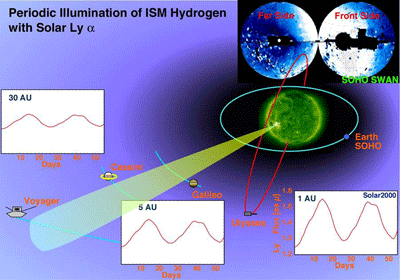Highlights - Volume 491-1 (November III 2008)
- Details
- Published on 30 November 1999
| HIGHLIGHTS: this week in A&A |
Volume 491-1 (November III 2008)
| Special issue Diagnostics of interstellar hydrogen in the heliosphere A&A 491, p. 1-68 This special section combines three complementary observation methods of determining the interstellar H parameters in the heliosphere, in particular the crucial H density at its boundary. It also shows how these results, in concert with global modeling, constrain the circumsolar interstellar environment. Results from the slowdown of the solar wind through H pickup (Richardson et al., p. 1), measurements of H pickup ion fluxes (Bzowski et al., p. 7), and analysis of solar Ly alpha backscattering at interstellar H (Pryor et al., p. 21; Nakagawa et al., p. 29) provide consistent values for the H density at the termination shock of ˜0.09 ± 0.022 cm-3. Müller et al., p. 43, present a comprehensive comparison of different modeling approaches to the interaction between the heliosphere and its neighborhood, while Slavin and Frisch, p. 53, show how the results reported here, together with those in a previous special section on “Diagnostics of Interstellar helium in the Heliosphere” (A&A, Vol. 426, 2004), constrain the ionization state and the radiation environment of the local neighborhood of our solar system. |
|
| In section 4. Extragalactic astronomy “High-ion absorption in seven GRB host galaxies at z=2-4. Evidence for both circumburst plasma and outflowing interstellar gas”, by A. J. Fox et al., A&A 491, p. 189 The authors made use of the UVES spectrograph on VLT to observe 7 gamma-ray bursts (GRB) with high spectral resolution and at a redshift between 2 and 4. They detect absorption lines of highly-ionized ions, with a velocity within 5000 km/s of the galaxy hosting the GRB. The velocity structures of the various absorption lines are complex and very rich in information, so the authors were able to determine which ones are from the area just around the burst and which are from the interstellar medium of the host galaxy. Models involving high-velocity stellar winds (from Wolf- Rayet stars) can be tested. |
| In section 6. Interstellar and circumstellar matter “The Antares emission nebula and mass loss of alpha Scorpii A”, by by D. Reimers et al., A&A 491, p. 229 Determining stellar mass loss is always difficult, but occasionally nature makes things easier for us. One such case is the Antares nebula that is produced in the circumstellar envelope surrounding a binary consisting of an M1.5 supergiant and a B2.5 main sequence star. This particular combination allowed Reimers et al. to use UVES on the VLT to derive an extremely accurate mass-loss rate for the supergiant and to show that N in the supergiant wind has an abundance enhanced by a factor of 3. |
| In section 9. The Sun “Magnetic flux cancellation associated with a recurring solar jet observed with Hinode, RHESSI, and STEREO/EUVI”, by C. Chifor et al., A&A 491, p. 279 "In this paper a recurring plasma jet in the solar atmosphere is investigated in detail using a suite of instruments operating at wavelengths from radio to X-rays. In this particular example the flow is found to be caused by evaporation of chromospheric material that is heated by magnetic reconnection in the corona. This sheds new light on the driver of dynamic jet-like phenomena in the upper solar atmosphere." |
© Astronomy & Astrophysics 2008


